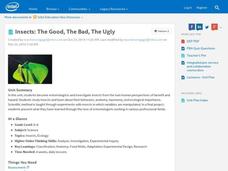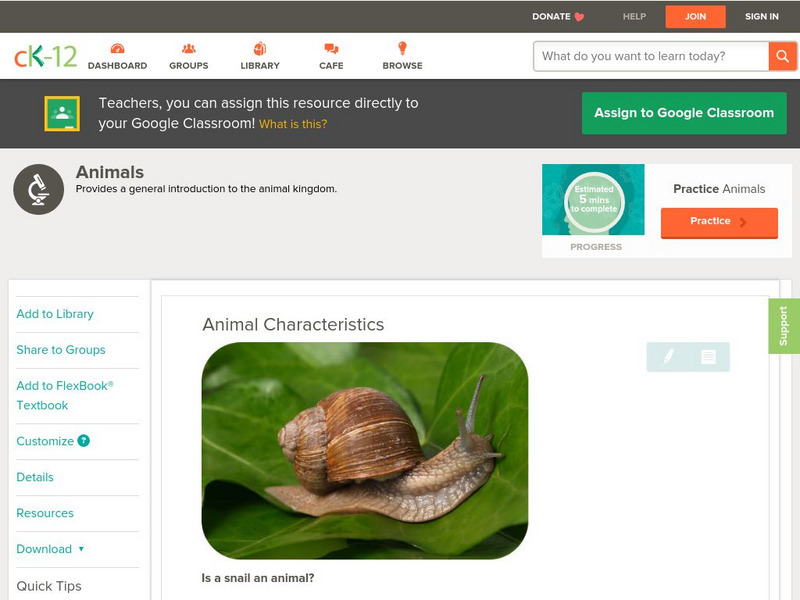Core Knowledge Foundation
Classification of Animals Tell It Again!™ Read-Aloud Anthology
Animal classification is the theme of a three-week read-aloud anthology. Scholars listen to and discuss a reading and complete extension activities throughout nine lessons. Writing opportunities delve deep into the process of writing an...
Columbus City Schools
Get Your Organisms Organized
From large to small, show your class how to organize them all! Included within the guide is everything you need to take their knowledge of classification from the cellular to the species level. The worksheets focus on...
Intel
Insects: The Good, The Bad, The Ugly
What would the world be like with no insects? Ponder this question using a research-based STEM unit that encourages scholars to investigate insects from both a beneficial and hazardous perspective. They learn about insect behaviors,...
Curated OER
Everything in Its Place: Science Classification
Students investigate the system of classification for living things through the sixteen lessons of this unit. The five kingdoms of monerans, protists, fungi, plants, and animals form the basis of several experiments as the similarities...
Homeschool Share
Lion Lapbook
Is your class in the mood for a fantastic set of lion-themed activities? Foldables, worksheets, writing prompts, and simple-to-read information are yours for the taking! Intended to accompany a unit on lions, this resource provides...
Curated OER
Classy
Students explore the classification system in this seven lessons unit. The diversity of life forms and their characteristics are examined using a microscope. Kingdoms, classes, and families are investigated.
Lerner Publishing
Meet the Dinosaurs
Take your class of youngsters on a prehistoric adventure with this four-lesson series on dinosaurs. Accompanying the Meet the Dinosaurs books by Don Lessem, these lessons engage children in writing their own dinosaur books,...
Curated OER
Write On! Step by Step Paragraph and Report Writing
Students plan and write paragraphs while integrating other core subject areas. In this paragraph writing lesson, students complete 5 lessons to practice writing paragraphs. Students incorporate various core subjects into their paragraph...
CK-12 Foundation
Ck 12: Episd: Animal Classification
[Free Registration/Login may be required to access all resource tools.] Check out the diverse traits that animals can have that put them into different Phyla to make it easier to classify them.
CK-12 Foundation
Ck 12: Biology: Animal Classification
[Free Registration/Login may be required to access all resource tools.] Overview of classifying animals.
TED Talks
Ted: Ted Ed: Cannibalism in the Animal Kingdom
Until recently, scientists thought cannibalism was a rare response to starvation or other extreme stress. Well-known cannibals like the praying mantis and black widow were considered bizarre exceptions. But now, we know they more or less...
TED Talks
Ted: Ted Ed: Meet the Tardigrade, the Toughest Animal on Earth
This 1-millimeter animal can survive both the hottest and coldest environments on earth, and can even withstand high levels of radiation. Thomas Boothby introduces us to the tardigrade, one of the toughest creatures on Earth. [4:10]
TED Talks
Ted: Ted Ed: The Evolution of Animal Genitalia
Genitals are the fastest-evolving organs in the animal kingdom. Menno Schilthuizen explains how the evolutionary biology of nature's nether regions uncovers a hidden world of seduction, conflict, and rivalry.
CK-12 Foundation
Ck 12: Episd: Animal Characteristics
[Free Registration/Login may be required to access all resource tools.] Students will be able to identify and classify organisms that are animals based on recognition of traits presented.
E-learning for Kids
E Learning for Kids: Science: Easter Island: Why Do Young Grow Up to Look Like Their Parents?
Kevin and his grandfather, Omag are going to the zoo. Join them and learn all about animal classification and life cycles.
CK-12 Foundation
Ck 12: Biology: Animal Characteristics
[Free Registration/Login may be required to access all resource tools.] Overview of animals.
CK-12 Foundation
Ck 12: Third Grade Science: Life Sci: Animal Characteristics and Classification
[Free Registration/Login may be required to access all resource tools.] Presents an overview of the major animals groups (mammals, birds, reptiles, amphibians, fish, arthropods, vertebrates, invertebrates, those having live births and...
TED Talks
Ted: Ted Ed: Inside the Ant Colony
Ants have one of the most complex social organizations in the animal kingdom; they live in structured colonies that contain different types of members who perform specific roles. Deborah M. Gordon explains the way these incredible...
Scholastic
Scholastic: Study Jams! Science: Animals: Kingdoms of Life
A playful interactive introducing biology's five animal kingdoms. Watch the video, take a quiz, and review vocabulary.
Scholastic
Scholastic: Study Jams! Science: Plants: The Kingdoms of Life
A video, a karaoke song to sing along to, and a 7-question multiple-choice quiz on the topic of Kingdoms in the life classification system.
Georgia Department of Education
Ga Virtual Learning: Biology: Animals
Through video clips. informational text, interactive activities, and assessment opportunities, students study and learn about the classification of animals.
Wonderville Media
Animal World/wonderville: Dogs
Dogs have needs just like you. They need food, water, shelter, grooming, exercise, health care, and love. Learn more about dogs in this well-constructed overview by Wonderville.
Georgia Department of Education
Ga Virtual Learning: Ap Biology: Animals
This unit focuses on the unique structure and function of both invertebrate and vertebrate animals. Students review their understanding of animal diversity, and take a closer look at the various organ systems found in the animal kingdom.
TeachEngineering
Teach Engineering: Biodomes
Students explore the biosphere's environments and ecosystems, learning along the way about the plants, animals, resources and natural cycles of our planet. Over the course of lessons 2-6, students use their growing understanding of...






















